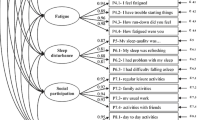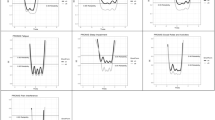Abstract
Purpose
To evaluate the equivalence of the PROMIS® physical functioning item bank by language of administration (English versus Spanish).
Methods
The PROMIS® wave 1 English-language physical functioning bank consists of 124 items, and 114 of these were translated into Spanish.
Analysis
Item frequencies, means and standard deviations, item-scale correlations, and internal consistency reliability were calculated. The IRT assumption of unidimensionality was evaluated by fitting a single-factor confirmatory factor analytic model. IRT threshold and discrimination parameters were estimated using Samejima’s Graded Response Model. DIF by language of administration was evaluated.
Results
Item means ranged from 2.53 (SD = 1.36) to 4.62 (SD = 0.82). Coefficient alpha was 0.99, and item-rest correlations ranged from 0.41 to 0.89. A one-factor model fits the data well (CFI = 0.971, TLI = 0.970, and RMSEA = 0.052). The slope parameters ranged from 0.45 (“Are you able to run 10 miles?”) to 4.50 (“Are you able to put on a shirt or blouse?”). The threshold parameters ranged from −1.92 (“How much do physical health problems now limit your usual physical activities (such as walking or climbing stairs)?”) to 6.06 (“Are you able to run 10 miles?”). Fifty of the 114 items were flagged for DIF based on an R 2 of 0.02 or above criterion. The expected total score was higher for Spanish- than English-language respondents.
Conclusions
English- and Spanish-speaking subjects with the same level of underlying physical function responded differently to 50 of 114 items. This study has important implications in the study of physical functioning among diverse populations.




Similar content being viewed by others
References
Shorris, E. (1992). Latinos: A biography of the people. New York: W.W. Norton & Co.
Morales, L., Kington, R., Valdez, R., et al. (2002). Socioeconomic, cultural, and behavioral factors affecting hispanic health outcomes. Journal of Health Care Poor Underserved, 13(4), 477–503.
California State Department of Finance. (2002). Current population survey report: March 2001 data. Sacramento, November 2002.
Los Angeles County Department of Health Services. (2000). Data collection and analysis division. Los Angeles: Vital Statistics of Los Angeles County.
U.S. Census Bureau: Census 2000 US Demographic profile and population center. Washington, DC 20033 (NP-T4-F) Projections of the total resident population by 5-year age groups, race, and Hispanic origin with special age categories.
U.S. Census Bureau: Current population reports (P25-1130) Population projections of the US by age, sex, race, and Hispanic origin.
http://www.census.gov/newsroom/releases/archives/2010_census/cb11-cn146.html.
http://www.census.gov/newsroom/releases/archives/population/cb08-123.html.
http://seniorjournal.com/NEWS/SeniorStats/5-05-31ProfileOlderAm2004.html.
Rose, M., Bjorner, J. B., Becker, J., et al. (2008). Evaluation of a preliminary physical function item bank supported the expected advantages of the Patient-Reported Outcomes Measurement Information System (PROMIS). Journal of Clinical Epidemiology, 61, 17–33.
Bruce, B., Fries, J. F., Ambrosini, D., et al. (2009). Better assessment of physical function: Item improvement is neglected but essential. Arthritis Research & Therapy, 11, R191. doi:10.1186/ar2890.
Cella, D., Riley, W., Stone, A., et al. (2010). The Patient-Reported Outcomes Measurement Information System (PROMIS) developed and tested its first wave of adult self-reported health outcome item banks: 2005–2008. Journal of Clinical Epidemiology, 63, 1179–1194.
Teresi, J. A., Ocepek-Welikson, K., Kleinman, M., et al. (2009). Analysis of differential item functioning in the depression item bank from the Patient Reported Outcome Measurement Information System (PROMIS): An item response theory approach. Psychology Science Quarterly, 51(2), 148–180.
http://research.yougov.com/services/scientific_research/ from http://www.polimetrix.com.
Rivers, D. (2006). Sample matching: representative sampling from Internet panels. Palo Alto, CA: Polimetrix, Inc.
Liu, H., Cella, D. F., Gershon, R., Shen, J., Morales, L. S., Riley, W., et al. (2010). Representativeness of the PROMIS internet panel. Journal of Clinical Epidemiology, 63(11), 1169–1178.
Bonomi, A. E., Cella, D. F., Hahn, E. A., Bjordal, K., Sperner-Unterweger, B., Gangeri, L., et al. (1996). Multilingual translation of the Functional Assessment of Cancer Therapy (FACT) quality of life measurement system. Quality of Life Research, 5, 309–320.
Cella, D., Hernandez, L., Bonomi, A. E., Corona, M., Vaquero, M., Shiomoto, G., et al. (1998). Spanish language translation and initial validation of the functional assessment of cancer therapy quality-of-life instrument. Medical Care, 36, 1407–1418.
Lent, L., Hahn, E., Eremenco, S., Webster, K., & Cella, D. (1999). Using cross-cultural input to adapt the Functional Assessment of Chronic Illness Therapy (FACIT) scales. Acta Oncologica, 38, 695–702.
MPlus: Muthen & Muthen. www.statmodel.com/.
Reeve, B. B., Hays, R. D., Bjorner, J. B., Cook, K. F., Crane, P. K., Teresi, J. A., et al. (2007). Psychometric evaluation and calibration of health-related quality of life item banks: plans for the Patient-Reported Outcomes Measurement Information System (PROMIS). Medical Care, 45(5 Suppl 1), 22–31.
Morales, L. S., Flowers, C., Gutierrez, P., et al. (2006). Item and scale differential functioning of the mini-mental state exam assessed using the Differential Item and Test Functioning (DFIT) framework. Medical Care, 44, S143–S151.
Du Toit, M. (2003). IRT from Scientific Software International. Chicago, IL: SSI, Inc.
Choi, S., Gibbons, L., & Crane, P. (2011). Lordif: An R package for detecting differential item functioning using iterative hybrid ordinal logistic regression/item response theory and Monte Carlo simulations. Journal of Statistical Software, 39(8).
Choi, S. W. (2009). Firestar: Computerized adaptive testing simulation program for polytomous item response theory models. Applied Psychological Measurement, 33(8), 644–645.
Eremenco, S., Cella, D., & Arnold, B. (2005). A comprehensive method for the translation and cross-cultural validation of health status questionnaires. Evaluation and the Health Professions, 28(2), 212–232.
http://www.census.gov/hhes/socdemo/education/data/cps/2010/tables.html.
Acknowledgments
This paper was supported in part by an NIH cooperative agreement (1U54AR057951). Sylvia H. Paz and Ron D. Hays were supported in part by a grant from the NIA (P30AG021684). Sylvia H. Paz was also supported by NIH/NCRR/NCATS UCLA CTSI Grant Number UL1TR000124. Ron D. Hays was also supported by UCLA/DREW Project EXPORT, NIMHD, (2P20MD000182). The papers’ contents are solely the responsibility of the authors and do not necessarily represent the official views of the NIH.
Author information
Authors and Affiliations
Corresponding author
Electronic supplementary material
Below is the link to the electronic supplementary material.
Rights and permissions
About this article
Cite this article
Paz, S.H., Spritzer, K.L., Morales, L.S. et al. Evaluation of the Patient-Reported Outcomes Information System (PROMIS®) Spanish-language physical functioning items. Qual Life Res 22, 1819–1830 (2013). https://doi.org/10.1007/s11136-012-0292-6
Accepted:
Published:
Issue Date:
DOI: https://doi.org/10.1007/s11136-012-0292-6




